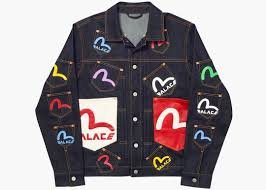In the crowded world of denim, where mass production and machine-perfect uniformity often drown out individuality, Evisu stands apart like a bold brushstroke on a blank canvas. Known for its unmistakable gull-wing logo painted on the back pockets, Evisu isn’t just selling jeans—it’s selling a living piece of wearable art. The brand’s hand-painted heritage is more than a design choice; it is a declaration of artistry, culture, and defiance against the disposable nature of fast fashion.
The Origins of a Painted Icon
Evisu was born in 1991 in Osaka, Japan, founded by Hidehiko Yamane—a man with a passion for vintage denim and traditional Japanese craft. At the time, selvedge denim production had nearly vanished in Japan, with only a few mills still weaving fabric on old shuttle looms. Yamane, obsessed with the authentic textures and durability of these fabrics, sourced the highest-quality denim from the legendary Kurabo Mills.
But quality alone was not enough. Yamane wanted to mark each pair with something unmistakably his own—something that would blend Japanese artistry with street-level swagger. The result was the now-famous seagull logo, painted by hand on each pocket. This wasn’t just branding; it was a brushstroke of identity. No two were ever exactly the same, turning each jean into a one-of-a-kind creation.
A Nod to Tradition, A Step Toward Rebellion
In Japan, handcraft is deeply intertwined with cultural pride. From calligraphy to kimono painting, the brush is a sacred tool of expression. Yamane borrowed this ethos but pointed it in a rebellious direction. Instead of delicate scrolls or ceremonial robes, his brush met rugged indigo denim. The gull wings symbolized freedom—a daring flight above the conformity of the fashion industry.
The early days of Evisu jeans saw Yamane himself painting each logo in his Osaka workshop. Customers often had to wait weeks for their jeans because production was slow, but that waiting was part of the ritual. It was as if the jeans were not merely being made but being consecrated.
The Power of the Hand-Painted Touch
In a world accustomed to machine-perfect lines, the imperfections of a hand-painted gull are its glory. The slight variations in thickness, the way the paint interacts with the grain of the fabric, even the occasional wobble—all contribute to the charm. These imperfections speak to the human touch, reminding the wearer that their jeans were not spat out by a factory line, but touched, marked, and blessed by an artisan.
The hand-painting process involves carefully masking the pocket area, applying special textile paint, and allowing it to dry in natural conditions. Over time, as the jeans fade and the paint cracks, the gull logo evolves alongside the denim’s whiskers, honeycombs, and fades. This creates a living visual record of both the artisan’s work and the wearer’s journey.
From Osaka Streets to Global Catwalks
While Evisu’s early customers were denim purists and vintage enthusiasts, the brand’s bold graphics quickly caught the eye of global fashion influencers, particularly in the burgeoning streetwear scene of the late 1990s and early 2000s. Hip-hop artists began wearing Evisu, and the painted gull became a cultural signal—a badge of both taste and audacity.
For streetwear, the gull logo functioned almost like graffiti on denim: loud, unapologetic, and instantly recognizable. It was a way of saying, I don’t just wear fashion—I wear art. The logo also carried an air of exclusivity, as each painted pair represented hours of work and limited production runs.
The Cultural Symbolism of the Gull
Why a gull? While there’s no single definitive answer from Yamane, the bird’s associations with freedom, travel, and a wide-open horizon resonate deeply. The gull also subtly connects to Osaka’s identity as a port city—a place of movement, trade, and cultural exchange. On denim, the gull becomes both a brand mark and a metaphor for the journey a pair of jeans will take, from pristine indigo to faded relic.
Guarding the Craft Against Industrial Speed
As Evisu grew, the temptation to mechanize the painting process must have been immense. Yet, the brand has stubbornly protected its hand-painted tradition. Even today, many of Evisu’s premium lines are still adorned by artisans who paint each logo one at a time.
This is not a cheap or easy process. The paint must be mixed to the right consistency so it bonds without stiffening the fabric. The brush must move in confident sweeps—hesitation will show in the final product. And the painter must know exactly how the denim will behave after washing and fading. This intimate knowledge of material and technique is something that cannot be programmed into a machine.
Wear as a Form of Storytelling
One of the most beautiful aspects of Evisu’s painted heritage is how the design ages with the denim. As the indigo fades, the painted gull takes on new character—sometimes chipping, sometimes blending into the fabric’s softened surface. Each crack in the paint is a memory of a step taken, a place visited, a day lived.
Collectors often treasure their oldest pairs not because they are pristine, but because they bear the layered patina of time. In this sense, the gull is more than a logo—it’s a storytelling device.
Art Meets Exclusivity
In recent years, Evisu has embraced collaborations with artists, designers, and brands, creating limited editions that push the boundaries of the painted tradition. Some gulls are filled with intricate patterns, gold leaf, or even embroidery layered over paint. Others incorporate motifs from Japanese folklore or street art culture.
These special editions are not just clothing; they’re collectible works of art. Much like owning a print from a famous painter, owning a rare Evisu collaboration means holding a small piece of fashion history.
Why Hand-Painted Still Matters Today
In an era where speed, convenience, and automation dominate, the persistence of Evisu’s hand-painted heritage is quietly radical. It reminds us that craft has a soul, that imperfections can be beautiful, and that the time taken to make something well is part of its value.
When you wear Evisu jeans you’re wearing a philosophy: that fashion should not just be consumed but experienced. You’re also participating in a lineage that stretches from Japanese calligraphers to modern streetwear icons—a lineage held together by the bristles of a paintbrush.
The Future of Evisu’s Painted Legacy
As fashion trends shift and sustainability becomes a priority, Evisu’s slow, deliberate craftsmanship feels more relevant than ever. Hand-painting is inherently sustainable: it resists overproduction, values longevity, and turns each pair into something worth keeping. Rather than chasing disposable trends, Evisu leans into timeless artistry.
The gull may evolve in style or color, but its essence will remain. Each new brushstroke will still carry the bravado that has defined the brand since its beginnings—defiant, proud, and unapologetically human.
In the end, Evisu’s hand-painted heritage is more than an aesthetic choice. It’s a statement that in a world rushing toward uniformity, there’s still room for individuality; in a culture of mass production, there’s still space for a single human hand to leave its mark. The gull soars not just across denim, but across decades, proving that true artistry is never out of fashion.






